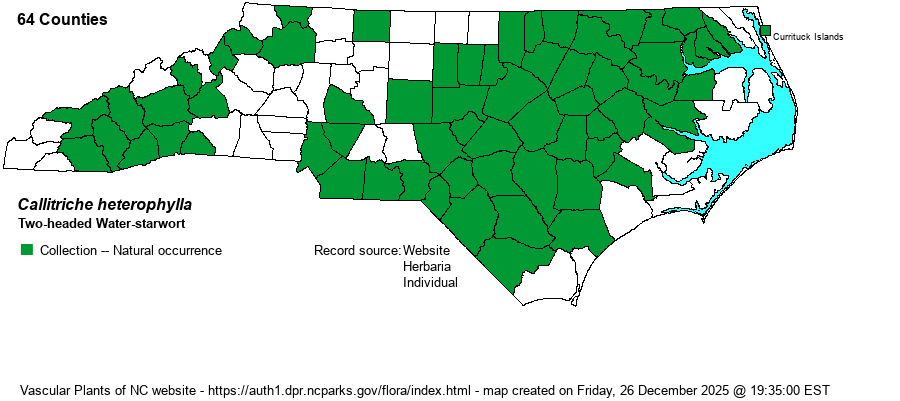| Author | Pursh | |
| Distribution | Throughout the Coastal Plain, except very scarce along the immediate coast. Present over the eastern Piedmont, and much of the Mountains, but oddly scarce in the western Piedmont.
This is a very widespread species, from eastern Canada south to southern FL and CA.
| |
| Abundance | Common in the Coastal Plain except for coastal areas, where rare to uncommon. Uncommon to fairly common in the eastern Piedmont, as well as in much of the Mountains; however, seemingly quite rare in the central and western Piedmont. | |
| Habitat | This is an aquatic species, of pools, ponds, slow-moving streams, canals, and wet ditches. | |
| Phenology | Flowers and fruits from March to October. | |
| Identification | This aquatic plant has a stem only about 6 inches long, typically with the lower leaves submerged and upper ones floating on the water surface; all are opposite. The submerged leaves are linear and only about 1/4-inch long, whereas the emergent leaves are spatulate or obovate, barely longer than 1/3-inch, with a tapering base. In fact, these emergent leaves are often crowded to appear a bit whorled. As the flowers have no petals and sepals, it is the fruits that are important for identification. The fruits, in axils, are "reversed heart-shaped", with a cleft in the top between rounded lobes at the apex. Nonetheless, the fruits are barely 1/15-inch long -- i.e., nearly microscopic. Those in this species are longer than wide, though it is better separated from the other two NC species by the leaves of two shapes -- linear submerged and spatulate emergent, as opposed to all leaves spatulate or obovate with rounded tips in the other two. | |
| Taxonomic Comments | The taxon in NC is the nominate one -- C. heterophylla var. heterophylla.
| |
| Other Common Name(s) | Large Water-starwort, Common Water-starwort | |
| State Rank | S5 | |
| Global Rank | G5 | |
| State Status | | |
| US Status | | |
| USACE-agcp | OBL link |
| USACE-emp | OBL link |

